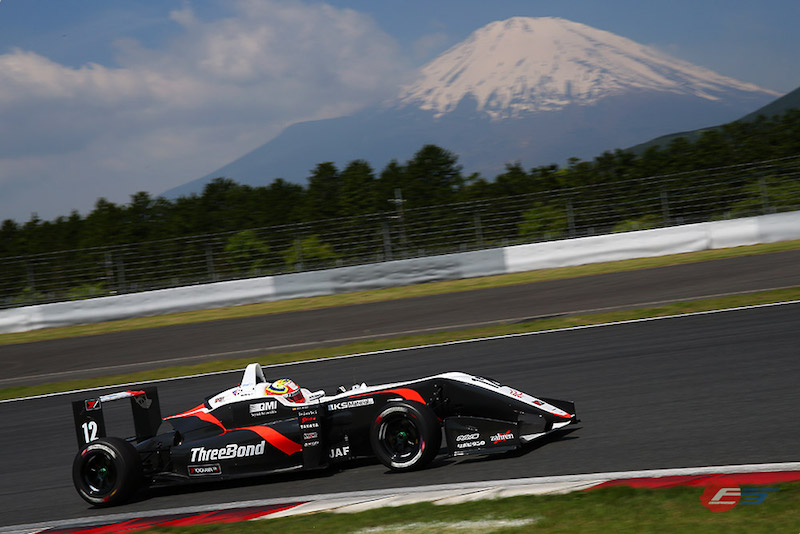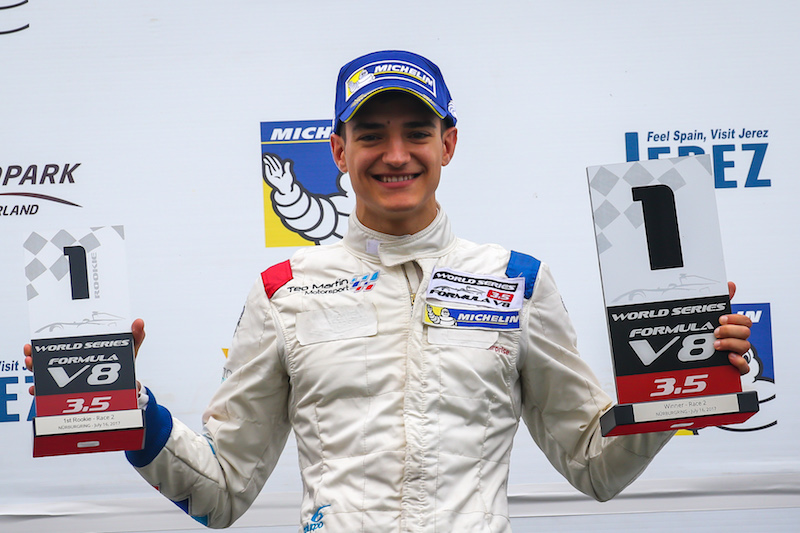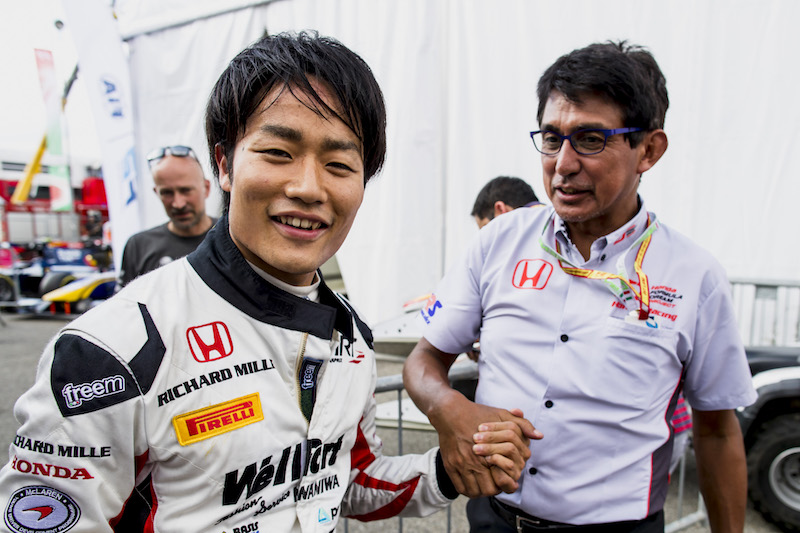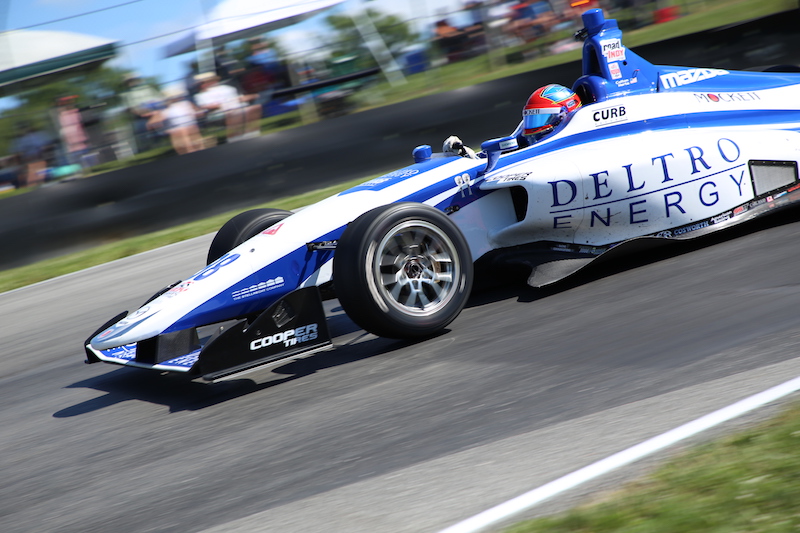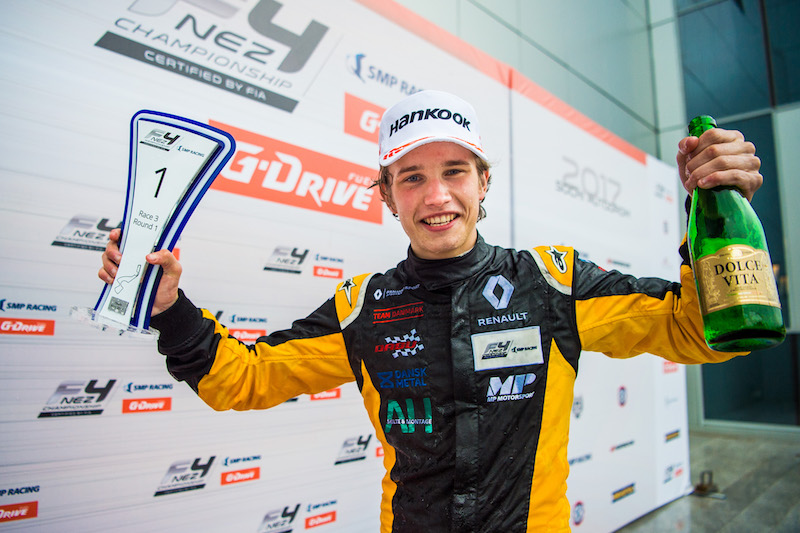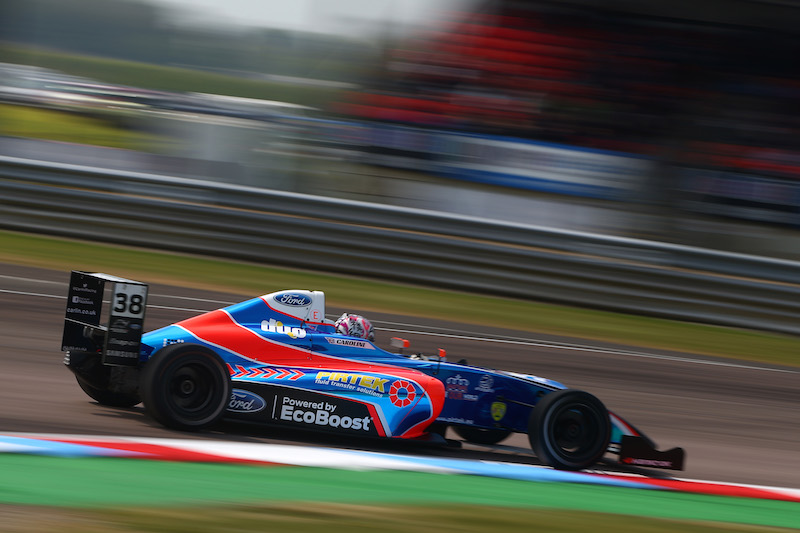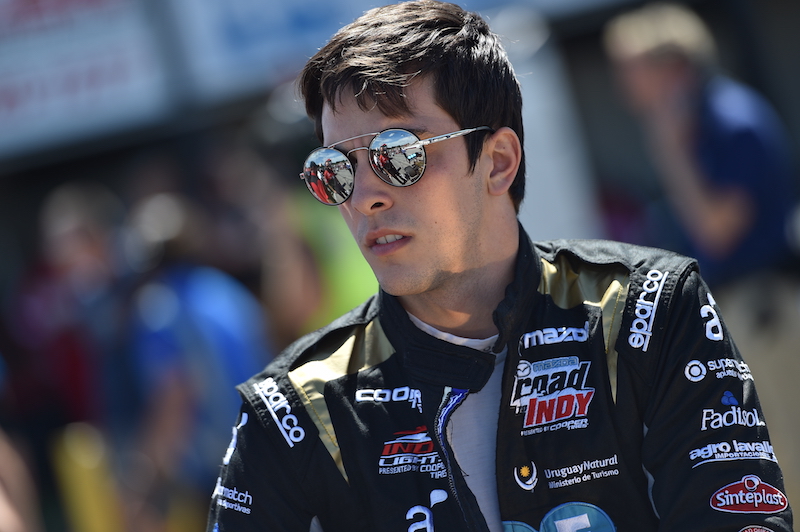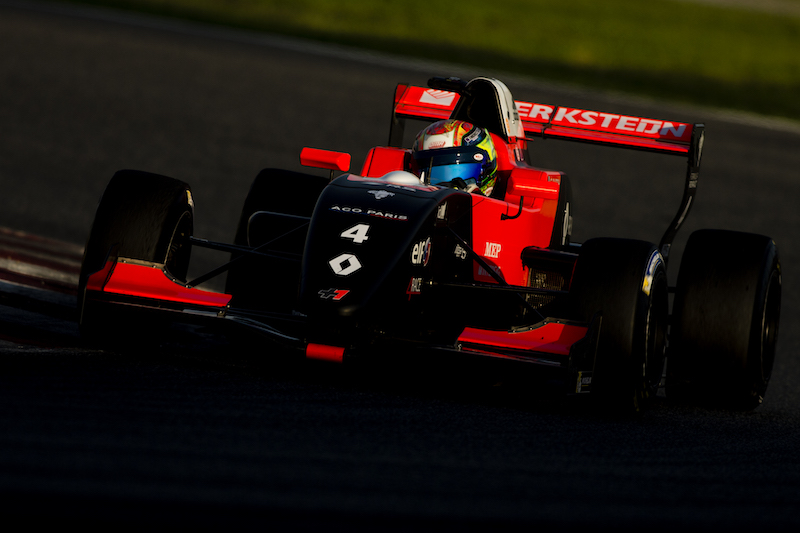Part two of our countdown of the best junior single-seater racers of this year features those from positions 40 to 31.
See also
Part 1: 50 to 41
40. Oliver Askew
New entry
USF2000 champion in first full season in cars
Having had to wait for his first proper chance in a single-seater,?Askew is now making the most of every opportunity that he earns.
After being selected for the Team USA Scholarship last year, he starred in the prize drives in Formula Ford 1600 in Britain that came with that. It also got him a place in the Mazda Road to Indy’s first shootout for a USF2000 ride, and he won won that.
This year, he turned that ride into a championship-winning campaign in the category’s first year with the modern European-style Tatuus chassis. He was hard to beat from the off, following up second place in the season opener with five successive wins.
Fellow karting graduate Rinus VeeKay did an impressive job after a last-minute change of team to take the title race down to the final race at Watkins Glen, which he won, and end up just seven points shy.
But Askew was still the dominant driver in pure speed terms with eight poles, and was hampered mostly by two low scores out of his control: a mechanical problem at Road Atlanta and getting caught in somebody else’s accident in Toronto.
The MRTI rewards opportunism and another scholarship will take Askew to Pro Mazda next year, and if he keeps it up he could win his way into IndyCar.
39. Alex Palou
Re-entry (50th in 2015)
Winner in Japanese F3 and Formula V8 3.5
Racing in three junior single-seater categories in one year is usually something that’s only possible for the best-funded of drivers, but Palou managed it in 2017 despite a distinct lack of budget. And the same talent that earned him those opportunities in the first place was on display every time.
After two challenging seasons in GP3 with mentor Adrian Campos, Palou headed to Japanese Formula 3 at the start of the year, driving for the ThreeBond-funded Tomei engine project that was previously based in the European series with T-Sport.?
He immediately upset the domestic establishment, taking pole for his first race and winning on his debut weekend. After two further wins within the first four rounds, he was rivalling Nissan’s veteran Mitsunori Takaboshi for the title. The form was not quite so strong in the second half of the season, but in the meantime, Palou was making a name for himself elsewhere.
He had set the pace in his first test in a Formula V8 3.5 car at Jerez last winter with Teo Martin’s team, and although he had to wait to race the car, he grabbed the opportunity with both hands, showing up the field by taking two pole positions and a win on his debut at the Nurburgring. Further podiums came in Mexico City and Austin.
Campos had always wanted to put his protege into his Formula 2 team this season, and managed to make that happen for the final two rounds. Again, Palou shone on debut, grabbing eighth in the feature race and leading much of the sprint race, but ultimately burned up his tyres too soon.
While Palou would deserve a full-time shot in F2 next year, he has never got on with the deliberate tyre degradation and other options could prove wiser. Tested by Audi’s DTM operation for the third time in four years, he has been linked to a European F3 ride with Hitech, and it would also be a surprise if he didn’t receive an offer in Super Formula after being the top rookie in recent testing.
38. Nobuharu Matsushita
Re-entry (47th in 2015)
Sixth in F2
Matsushita put a tough second season racing the GP2/11 behind him with a much-improved effort in 2017. Yet while the Honda junior got closer than ever to an opening in Formula 1, his season may not have been strong enough for him to keep that dream alive.
He added the third and fourth sprint race wins of his GP2/F2 career in Barcelona and Hungary, and they can’t be dismissed as easy: he started fifth and fourth on the grid respectively, with good starts proving handy.
His feature race form was not so strong, with third place in Monaco probably the best performance. He was excellent to take pole position in Monza just days after crashing heavily at Spa, and it would have been interesting to see whether he could have converted it in a dry race. His pace in the wet was poor and he was fortunate to end up with second place.
The ART Grand Prix cars rarely looked capable of contending for feature race victories this year if at all, and Matsushita just about had the beating of team-mate Alex Albon who arrived with momentum from GP3. But it’s worth remembering that Matsushita is one of few constants at the team from the heady days of Stoffel Vandoorne.
Having had his first F1 tests with Sauber thanks to the Honda engine deal that never was, he could have been in contention for a chance at Toro Rosso. But the fact that his F2 results haven’t been good enough to earn a superlicence put paid to that, and his future may lay back on the domestic scene in Super Formula.
37. Colton Herta
New entry
Third overall and top rookie in Indy Lights
The continued rise of Lando Norris goes to show just how good a job Colton Herta did to get on terms with his then-team-mate while in his first season in Europe in MSA Formula in 2015.
Despite further promise in Euroformula Open, he returned home to the United States last winter for an Indy Lights seat with Andretti, and showed that Europe’s loss will be America’s gain.
Even though he was still only 16 at the time, he was a winner on his debut in IndyCar’s feeder series on the streets of St Petersburg. A second win followed next time out at Barber Motorsports Park, but it would be his last.
He took pole position on five further occasions, emphasising his outright speed, but he would only make the podium four more times – three of those coming in the final four races after a rough mid-season spell that included mechanical issues and several moments of contact.
The end result was third in the championship, but that was a fine effort behind two older, more experienced Mazda Road to Indy racers.
With his precocious speed, Herta has proven himself as a serious future IndyCar prospect, and if he can convert it into more points next season, he will be hard to stop.
36. Christian Lundgaard
New entry
SMP and Spanish F4 champion
After starring in karting, Lundgaard was signed to Renault’s academy ahead of his first year in single-seaters, where he followed Richard Verschoor by winning both the SMP and Spanish Formula 4 series.
In the Russian-based SMP series he was dominant. After the first three rounds he had three wins, but he found another gear over the summer, with six wins over the next three rounds. He might have had a seventh if he hadn’t mistakenly served a drive-through penalty that was awarded to another driver, but he still finished the race as champion.
He began the Spanish series with a hat-trick at Aragon, but when it resumed after he sealed the SMP crown, he would win only two of the next 14 races.
SMP protege Alexander Smolyar seemed more at home away from home, and won eight of those races, while Lundgaard’s MP Motorsport team-mate Bent Viscaal got stronger too and took four wins, but with the pressure on, having had his advantage eroded to just three points, Lundgaard nailed the deciding round at Estoril.
Overall, Lundgaard was less imposing than Verschoor last year and he may find the move up to Formula Renault with MP to be similarly challenging, but two titles in his first season out of karts is a fine achievement regardless.
35. Jamie Caroline
New entry
British F4 champion
That Caroline won the British F4 title this year surprised nobody, but the way in which he opened up a huge advantage over the competition through the opening rounds was impressive.
The 2015 Ginetta Junior champion had shown flashes of promise during a disrupted rookie campaign, and a move to top team Carlin put him into a good position in what his fourth year racing on the same circuits.
He handled the pressure of expectation well, winning twice at Brands Hatch and again at Donington Park. Then came an incredible and spectacular hat-trick at Thruxton, which was all the more special coming in the first event after his childhood friend and rival Billy Monger’s accident.
There would be only three further wins as he lost his pace advantage, particularly in qualifying, to car racing rookies Oscar Piastri and Logan Sargeant. Caroline believed a heavy crash at Oulton Park had caused damage to his chassis, but it’s not uncommon for relative veterans?at this level to be caught up by rookies as a season wears on.
A particular purple patch for Piastri did force the title fight down to the wire, but, while appearing slightly frustrated, Caroline always seemed comfortable and was able to park his naturally attacking style in order to bank the points he needed.
With funds limited, his long-term future may lie away from single-seaters, but a step up to either BRDC British F3 or Euroformula Open with Carlin seems likely for 2018.
34. Matheus Leist
Up 5
Earns IndyCar shot with three wins in rookie Lights campaign
When he became British F3 champion in 2016, Leist initially set out to follow famous fellow Brazilians who had held the same title and make it to Formula 1. But he ended 2017 by becoming IndyCar team-mate to Tony Kanaan after an outstanding first campaign in the United States.
It wouldn’t have been a surprise if a driver schooled on the circuits of Brazil and Britain had taken well to American road courses, but where Leist really impressed was on ovals.
His form through the opening rounds was rather disappointing, but he was unstoppable in his first ever oval event at the Freedom 100, delivering Trevor Carlin a dream Indianapolis victory after dominating a race that’s frequently decided by the narrowest of margins.
In early July he added another oval triumph in Iowa, having won at Road America on the intervening race weekend.
By now, he was only 12 points off unconvincing series leader Kyle Kaiser, but Leist would finish higher than 10th just once in the next five races and finished up fourth in the standings.
His oval exploits had made an impression in IndyCar however, and with AJ Foyt Racing in particular. It won’t be the easiest place to make the step up, but there are few better he could have the chance to learn from than Kanaan.
33. Santiago Urrutia
Down 4
Second?again in Indy Lights after flying finish
Urrutia proved his class once again in Indy Lights this year, but early inconsistency cost him a title that would have guaranteed him the IndyCar opening he so clearly deserves.
Only team tactics had denied Urrutia the 2016 title against now-Ganassi racer Ed Jones, but the withdrawal of Schmidt Peterson Motorsports from the feeder category threatened the Uruguayan’s future before a tie-up with rival squad Belardi presented him with his second chance.
Despite Belardi’s successful record, it took time for the new partnership to really gel, and second-place finishes at St Petersburg, the Indianapolis road course and Road America were interspersed with poor results which left him trailing in the points race.
Another second at Iowa and third in race one in Toronto were followed by a mechanical issue, which combined with Kaiser’s double meant that when Urrutia finally hit his stride in the final four races – with two wins and two second places – it was too late.
Nonetheless, his late rally was proof of his determination and will to never give up, and he continues to apply the same attitude to realising his dream of racing in IndyCar.
32. Gabriel Aubry
New entry
Fifth in Formula Renault Eurocup
After they made the step up from French F4 to Formula Renault together with Tech 1 Racing in 2016, there was a clear gulf between race-winner Sacha Fenestraz and Aubry, who struggled to get up to speed.
But while Fenestraz lived up to expectations by claiming the Eurocup crown in 2017, Aubry made a big step forward to be just as strong on his day.
Staying with Tech 1, where he moved from fourth in the pecking order to become team leader over the winter, Aubry’s improvement was clear from the off, making the podium in the first race at Monza and starting from pole in the second.
A pair of wins at the same circuit in the Northern European Cup opener against quick team-mate Max Fewtrell got him off the park, and a week later he was twice victorious in the Eurocup at the Hungaroring at Fenestraz’s expense. He beat an in-form Fenestraz once more to take a win at Spa.
Aubry has tested in both F3 and GP3 recently, having shown this year that he’s capable of being competitive in either.
31. Max Defourny
Down 13
Fourth in Formula Renault Eurocup
After being Lando Norris’ toughest rival during 2016, Defourny deserved the chance to step up out of Formula Renault, and the decision to return for a third season probably did him few favours in the end.
Staying with R-ace GP, he was understandably a championship favourite, but with Will Palmer taking a good step forward in pace and Robert Shwartzman rapid after joining the team, Defourny was third-best in the opening rounds as the French squad dominated proceedings.
A double non-score at Silverstone, where he had twice topped his qualifying group, put him badly on the back foot. Thereafter, he actually outscored both Palmer and Shwartzman and reeled them in in the standings, sitting third ahead of Shwartzman going into the final round.
Post-Silverstone he finished in the top four in all but six of the remaining 19 races, but he relied upon the last-lap clash between Fenestraz and Shwartzman for his only win – his first in the Eurocup since the opening race of 2016.
As a consistent frontrunner in a series as competitive as the Eurocup however, Defourny has proven he can feature strongly at a higher level, which could be in European F3 with Van Amersfoort Racing after he scored points on his debut at the Nurburgring.


